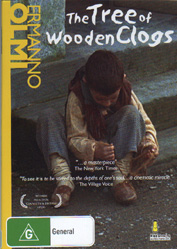The Tree of Wooden Clogs (1978) (NTSC) |
|
The Tree of Wooden Clogs (1978) (NTSC) |
|


|
| BUY IT |
| General | Extras | ||
| Category | Drama | None | |
| Rating |

|
||
| Year Of Production | 1978 | ||
| Running Time | 178:26 | ||
| RSDL / Flipper | Dual Layered | Cast & Crew | |
| Start Up | Menu | ||
| Region Coding | 1,2,3,4,5,6 | Directed By | Ermanno Olmi |
|
Studio
Distributor |
 Umbrella Entertainment |
Starring |
Luigi Ornaghi Francesca Moriggi Omar Brignoli Antonio Ferrari Teresa Brescianini Giuseppe Brignoli Carlo Rota Pasqualina Brolis Massimo Fratus Francesca Villa Maria Grazia Caroli Battista Trevaini Giuseppina Langalelli |
| Case | Amaray-Transparent-Secure Clip | ||
| RPI | $29.95 | Music | Johann Sebastian Bach |
| Video (NTSC) | Audio | ||
| Pan & Scan/Full Frame | Full Frame | Italian Dolby Digital 2.0 mono (192Kb/s) | |
| Widescreen Aspect Ratio | 1.29:1 | ||
| 16x9 Enhancement | No | ||
| Video Format | 480i (NTSC) | ||
| Original Aspect Ratio | 1.33:1 | Miscellaneous | |
| Jacket Pictures | No | ||
| Subtitles | English | Smoking | Yes |
| Annoying Product Placement | No | ||
| Action In or After Credits | No | ||
Italian filmmaker, Ermanno Olmi's background in film began with making documentaries in the early 1950's. He made his first feature film, Il Tempo si è fermato in 1959 and has since then, built up quite an extensive body of work, with credits that include nearly every aspect of filmmaking.
Born in Treviglio, a province of Bergamo, Italy in 1931, Ermanno Olmi was born into a peasant family and experienced the life that he would later write about in his most famous film, The Tree of Wooden Clogs.
Deserving a place with other classics in the Italian neorealist genre, The Tree of Wooden Clogs features no professional actors, which is an amazing achievement when you see how genuine the performances are in the film. This and other relevant factors are clear reasons why this film is widely regarded as Ermanno Olmi's most accomplished work and a worthy winner of the Palme d'Or at Cannes in 1978.
The film spans four seasons and is set in the Bergamo region of Italy in the late eighteen hundreds. It was common for many peasant families to live and work together in small communes and farm the land of wealthy landlords. The families would work tirelessly farming crops on the borrowed land, but would only get to sell one third of their produce - the balance going to the landlord as rent payment.
The Tree of Wooden Clogs follows the lives of four families in one such community. Rather than a conventional plot, the film gives us glimpses into the everyday lives of these four families. Without grievance, we witness the many hardships and social injustices endured by these peasant families. Olmi balances their adversity with subtle humour and their strong religious belief that delivers strength and faith for a better life.
As previously mentioned, the film doesn't follow a conventional dramatic plot, so rather than outline each story in the film; I will simply concentrate on the central story, which gives the film its title.
Batisti (Luigi Ornaghi) and his wife Batistina (Francesca Moriggi) are told by the village priest that their young son, Minek (Omar Brignoli) is very intelligent and should go a school. Batisti and Batistina want to give Minek every chance in life, so they agree to make the necessary sacrifices.
Each day, five-year-old Minek must make the long journey to school on foot. His only shoes are a pair of wooden clogs, which are not at all adequate for the journey. One day before he sets off on the journey home, one of the clogs breaks in half.
After the recent birth of their third child, Batisti does not want to worry Batistina with the news of the broken clog, so he decides to keep it secret. Batisti goes into the landlord's private grove and chops down a tree with the intension of using the suitable timber to remake the broken clog. Late at night while his family sleeps, Batisti shapes the wood and creates a new clog for young Minek.
Some days later, the landlord notices the deliberately felled tree. Furious, he sends his bailiff to find the perpetrator and evict he and his family from the property.
Against the sombre tone of the film, is a sublime beauty that is really quite beguiling. Not only was The Tree of Wooden Clogs written, directed and edited by Ermanno Olmi, but it was also beautifully photographed by him - it is a film that everyone should see at least once in his or her lifetime.
Footnote: It is worth noting that although the film has received a G rating for General Exhibition, it does show two scenes of animal slaughter. This is entirely within the context of the film and is not exploitive in anyway, however, it is worth mentioning for those with young children. Perhaps a PG (Parental Guidance) rating might have been more apt.
The video transfer for The Tree of Wooden Clogs is surprisingly quite good. This is a NTSC transfer, so make sure your equipment is capable of playing and displaying this format.
The film is presented fullscreen in an aspect ratio of 1.29:1 and is not 16x9 enhanced. The correct aspect ratio for this film is 1.33:1.
Generally speaking, the film displays a good degree of sharpness and clarity. I was expecting a very grainy transfer, but thankfully, grain was minimal and not at all problematic. In any case, the grain that is present is almost certainly inherent in the source material. Blacks were mostly clean, with just the occasional appearance of noise. Shadows were also very good and held a fine level of detail.
The very natural colour palette of earth tones appeared nicely balanced, with no oversaturation issues.
There were no MPEG artefacts in the transfer and thankfully, film-to-video artefacts were insignificant. Film artefacts were minor in nature, consisting of light marks and scratches that were really only noticed if you were concentrating on them.
The only subtitles on the disc are English. They are easy to read in bright white, which contrasts well with this film. Regarding these subtitles, one aspect that was rather annoying was the fact that only relevant passages of dialogue have received subtitles. This means that many brief passages of dialogue are without translation - unless you happen to speak Italian. Although, I'm sure this doesn't have any adverse bearing on following and comprehending the film, it is somewhat untidy and lazy.
This is a single sided, dual layer disc. The layer change is reasonably well placed within a dark scene at 89:13.
| Sharpness | |
| Shadow Detail | |
| Colour | |
| Grain/Pixelization | |
| Film-To-Video Artefacts | |
| Film Artefacts | |
| Overall |
The audio transfer is naturally very basic, but perfectly acceptable.
There is only one audio track available on the DVD, Italian Dolby Digital 2.0 mono (192Kb/s).
The dialogue throughout seems to be clean, however the film has some post dubbing, which is particularly obvious early in the film. This is not an issue with the transfer, so apart from this, audio sync appears very good.
There is no original music score for The Tree of Wooden Clogs. Instead, some wonderful organ music by Johann Sebastian Bach is used to great effect. These pieces of music suit the ambience of the film very well.
The surround channels and subwoofer were not used.
| Dialogue | |
| Audio Sync | |
| Clicks/Pops/Dropouts | |
| Surround Channel Use | |
| Subwoofer | |
| Overall |
There are no extras on this disc.
The main menu is well themed and features subtle animation, 16x9 enhancement and a sample of music used in the film.
NOTE: To view non-R4 releases, your equipment needs to be multi-zone compatible and usually also NTSC compatible.
I will compare this local all region edition of The Tree of Wooden Clogs with the R1, Koch Lorber release, dated July 13th 2004.
The only difference between these versions is the R1 version features two minor extras. These being a theatrical trailer of the film and a photo gallery. Unless for some reason these minor extras are important, I would stick with this local edition simply out of convenience.
Ermanno Olmi's 1978 epic, The Tree of Wooden Clogs is a superb film in the neorealist genre. Its depiction of peasant family life in turn of the century Italy is as sublime as it is poignant. If you love fine Italian cinema, then this film is an absolute must for your DVD collection.
The video and audio transfers are surprisingly good.
Unfortunately, there are no extras.
| Video | |
| Audio | |
| Extras | |
| Plot | |
| Overall |
| Review Equipment | |
| DVD | JVC XV-N412, using Component output |
| Display | Hitachi 106cm Plasma Display 42PD5000MA (1024x1024). Calibrated with THX Optimizer. This display device is 16x9 capable. This display device has a maximum native resolution of 1080i. |
| Audio Decoder | Built in to amplifier/receiver. Calibrated with THX Optimizer. |
| Amplification | Panasonic SA-HE70 80W Dolby Digital and DTS |
| Speakers | Fronts: Jensen SPX7 Rears: Jensen SPX4 Centre: Jensen SPX13 Subwoofer: Jensen SPX17 |